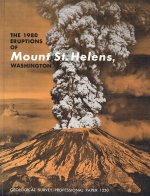|
|
|
|
|
|
|
|
|
|
|
|
|
 |
Volcanic Events, pg. 2 Mount St. Helens History, pg. 3-15 Eyewitnesses, pg. 53-67 Absolute Times, pg. 81-82, 86 Activity Sequence, pg. 127-134 Gas Studies, pg. 190-191 |
Chemical
Compositions, pg.
233-250
Ash Clouds, pg. 323-333 Blast Dynamics, pg. 379-400 Rapid Deposition, pg. 466-478 Phreatic Explosions, pg. 509-511 New Lava Dome, pg. 540-544 Ash-Fall Deposits, pg. 568-584 Water Chemistries, pg. 659-664 River Water Quality, pg. 719-731 |
THE 1980 ERUPTIONS OF MOUNT ST. HELENS, WASHINGTON
VOLCANIC EVENTS
Although Mount St. Helens apparently had been dormant since 1857, geologic studies of deposits around the flanks of the volcano indicate that it erupted frequently in the past and that the modern cone has grown largely during the past 2,500 yr (Mullineaux and Crandell). Eruptions of dacite as pyroclastic flows, ash falls, and viscous lava domes have alternated with lava flows of andesite and basalt. During most eruptive periods, pyroclastic flows and mudflows built fans of fragmental material around the base of Mount St. Helens and partly filled valleys leading away from the volcano. Before 1980, Mount St. Helens was considered by some volcanolo-gists to be the most likely of all Cascade volcanoes to erupt in the near future, and among the most hazardous because of the likelihood of explosive activity and proximity to populated areas.
The 1980 activity of Mount St. Helens (Christiansen and Peterson) began on March 20 with an intensifying swarm of earthquakes. The first steam-blast eruption, a week later, was associated with continued high levels of seismic activity, formation of a summit crater, and beginning of deformation of the north flank of the volcano. These processes continued intermittently through April up to the climactic eruption on the morning of May 18. The May 18 eruption was apparently triggered at 0832 PDT by a magnitude-5 + earthquake, not appreciably different from many preceding quakes, that caused multiple failures of the bulging north flank and produced great avalanches of rock debris. Unloading of the volcano by these failures led to a northward-directed lateral blast, partly driven by hydrothermal steam explosions, that devastated an area of nearly 600 km2. These events in turn triggered an explosive eruption of dacitic magma that drove a vertical column more than 25 km high, producing visible ash fall for more 1,500 km to the east, and pumiceous pyroclastic flows on the volcano's north flank. Catastrophic mudflows and floods were generated in part by rapid melting of snow and ice. Smaller magmatic eruptions occurred on May 25, June 12, July 22, August 7, October 16-18, and in late December, producing pyroclastic flows, ash falls, and several lava domes. Through December 1980, the eruptions tended to become progressively smaller in volume, slightly more mafic in composition, and less explosive.
The 1980 Mount St. Helens eruptions were especially well documented, because proximity to major population centers offered opportunities not commonly available for monitoring volcanic events in remote areas. An aircraft equipped with USGS large-format fix-mounted cameras, previously used for monitoring glaciers in the Pacific Northwest, was available throughout 1980 (Krimmel and Post). A selection from hundreds of high-quality photographs thus obtained documents surface deformation, crater enlargement, and ash and snow cover before May 18. On May 18, the castastrophic eruption was photographed from about at 1100 PDT until dark. Subsequent photographic coverage documents changes on the volcano later in 1980.
Remarkable documentation of the May 18 eruption also comes from ground-based photography and eyewitness accounts (Rosenbaum and Waitt). Because the eruption occurred under excellent weather conditions in daylight hours on a weekend, observers were present on all sides of the volcano. Observed phenomena of importance to subsequent scientific studies include small rock and ice avalanches that marked the 0832 PDT earthquake, the massive avalanches of the volcano's north flank, the subsequent laterally directed blast, development of the vertical eruption column, timing of mudflows, and the fall of early eruptive products.
A remarkable sequence of photographs taken from the northeast by Gary Rosenquist at intervals of 1-2 s
is especially useful in documenting events at the beginning of the May 18 eruption (Voight). Analysis
of these photographs provides a time scale for the beginning of the debris avalanche and directed
blast, as well as velocity estimates for these events. The avalanche began 10-20 seconds after the 0832
earthquake, and near-source velocities of the directed blast ranged from 50 to more than 200 m/s.
| START & IMAGES |
|